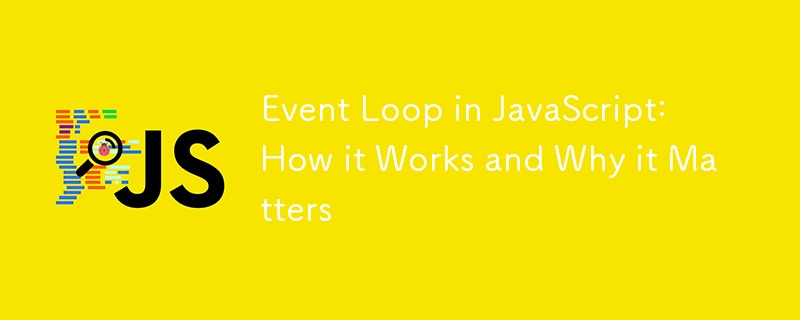ホームページ >ウェブフロントエンド >jsチュートリアル >JavaScript のイベント ループ: その仕組みと重要な理由
JavaScript のイベント ループ: その仕組みと重要な理由
- 王林オリジナル
- 2024-07-19 12:48:311054ブラウズ

JavaScript は、その単純さにもかかわらず、内部で複雑かつ強力なエンジンを実行しています。このエンジンの最も重要な側面の 1 つはイベント ループです。イベント ループを理解することは、JavaScript 開発者にとって非常に重要です。イベント ループは、非同期操作の処理、コードのスムーズな実行の確保、パフォーマンスの最適化において重要な役割を果たすからです。この記事では、JavaScript のイベント ループ、その仕組み、それが重要な理由を詳しく掘り下げ、理解を確実にするための実践的な例を示します。
JavaScript のイベント ループとは何ですか?
イベント ループは JavaScript ランタイムの基本的な部分であり、複数のコードの実行を管理し、非同期イベントを処理し、JavaScript エンジンが効率的に動作することを保証します。これにより、JavaScript をノンブロッキングかつシングルスレッド化できるため、ユーザー インターフェイスをフリーズさせることなく複数のタスクを処理できるようになります。
イベントループはどのように機能しますか?
イベント ループがどのように機能するかを理解するには、関連する主要なコンポーネントを把握することが不可欠です。
- 呼び出しスタック: JavaScript エンジンが関数呼び出しを追跡する場所。関数は呼び出されるとスタックにプッシュされ、完了するとスタックからポップされます。
- Web API: 非同期タスクを処理する setTimeout、DOM イベント、フェッチなどのブラウザー提供の API。
- コールバック キュー: Web API がタスクを完了するときにコールバック関数が保存されるキュー。
- イベント ループ: コール スタックが空かどうか、およびキュー内に実行を待っているコールバックがあるかどうかを継続的にチェックするループ。
イベント ループはコール スタックとコールバック キューを常にチェックします。コール スタックが空の場合、キューから最初のコールバックを取得し、コール スタックにプッシュして実行します。
イベントループの動作例
イベント ループを説明する簡単な例を次に示します。
console.log('Start');
setTimeout(() => {
console.log('Timeout');
}, 0);
console.log('End');
期待される出力:
Start End Timeout
この例では、console.log('Start') と console.log('End') が同期操作であり、コール スタックにプッシュされるため、最初に実行されます。 setTimeout 関数は非同期操作であるため、そのコールバックはコールバック キューにプッシュされ、コール スタックが空になった後にのみ実行されます。
イベントループが重要な理由
イベント ループを理解することは、いくつかの理由から重要です。
- 非同期操作の処理: JavaScript のノンブロッキングの性質は、イベント ループに依存して非同期タスクを効率的に処理します。これにより、コードは、各操作の完了を待ってから次の操作を開始することなく、複数の操作を同時に実行できるようになります。
- UI フリーズの回避: イベント ループは非同期タスクを効果的に管理することで、ユーザー インターフェイスのフリーズを防ぎ、スムーズなユーザー エクスペリエンスを提供します。
- パフォーマンスの最適化: イベント ループを適切に利用すると、より効率的なコード実行が可能になり、不必要な遅延が削減され、全体的なパフォーマンスが向上します。
よくある落とし穴とその回避方法
- 呼び出しスタックのブロック: 長時間実行される操作により呼び出しスタックがブロックされ、イベント ループが他のタスクを実行できなくなる可能性があります。これを回避するには、setTimeout や requestAnimationFrame などの関数を使用して、複雑な操作をより小さな非同期のチャンクに分割します。
- コールバック地獄: 複数の非同期コールバックをネストするとコールバック地獄に陥り、コードの読み取りと保守が困難になる可能性があります。これを回避するには、Promises または async/await 構文を使用して、非同期操作をより適切に処理します。
実践例
例 1: Promise を使用した非同期操作の処理
Promise は、従来のコールバックと比較して、非同期操作を処理するためのより読みやすい方法を提供します。
console.log('Start');
fetch('https://jsonplaceholder.typicode.com/posts/1')
.then(response => response.json())
.then(data => {
console.log('Data:', data);
});
console.log('End');
期待される出力:
Start
End
Data: {userId: 1, id: 1, title: '...', body: '...'}
この例では、フェッチ関数はネットワーク リクエストが完了すると解決される Promise を返します。 then メソッドは応答を非同期的に処理するために使用され、コールスタックがブロックされないようにします。
例 2: よりクリーンなコードのための Async/Await の使用
Async/await 構文により、非同期コードの外観と動作が同期コードのようになり、可読性が向上します。
console.log('Start');
async function fetchData() {
const response = await fetch('https://jsonplaceholder.typicode.com/posts/1');
const data = await response.json();
console.log('Data:', data);
}
fetchData();
console.log('End');
期待される出力:
Start
End
Data: {userId: 1, id: 1, title: '...', body: '...'}
ここで、fetchData 関数は await を使用して、fetch によって返された Promise が解決されるまで実行を一時停止します。これにより、コードが読みやすく、保守しやすくなります。
Deep Dive into the Event Loop Phases
Microtasks and Macrotasks
The Event Loop processes two types of tasks: macrotasks and microtasks. Understanding the difference between them is crucial for optimizing your code.
Macrotasks: These include events like setTimeout, setInterval, and I/O operations. They are queued in the callback queue and executed one at a time.
Microtasks: These include Promises and mutation observers. They are queued in the microtask queue and executed immediately after the current operation completes, but before any macrotasks.
Example: Microtasks vs. Macrotasks
console.log('Start');
setTimeout(() => {
console.log('Timeout');
}, 0);
Promise.resolve().then(() => {
console.log('Promise');
});
console.log('End');
Expected Output:
Start End Promise Timeout
In this example, the Promise is a microtask and is executed before the setTimeout macrotask, even though both are scheduled to run after the current stack is clear.
FAQs
How does the Event Loop handle DOM events?
The Event Loop handles DOM events through the Web APIs, which queue the event callbacks to the callback queue when the event is triggered. These callbacks are then processed by the Event Loop.
Can the Event Loop process multiple callbacks simultaneously?
No, the Event Loop processes one callback at a time. JavaScript is single-threaded, so it can only handle one operation at a time in the call stack.
What happens if a callback takes too long to execute?
If a callback takes too long, it can block the call stack, causing delays in processing other callbacks. This can lead to a sluggish user interface. To prevent this, break down long-running operations into smaller tasks using asynchronous techniques.
How do Web Workers relate to the Event Loop?
Web Workers run in separate threads from the main JavaScript execution thread, allowing you to perform background tasks without blocking the Event Loop. Communication between the main thread and Web Workers is handled via message passing.
Why is understanding the Event Loop important for performance optimization?
By understanding the Event Loop, developers can write more efficient code that handles asynchronous operations better, reduces blocking, and ensures smoother user interactions.
How do async/await and Promises fit into the Event Loop?
Async/await and Promises are abstractions over the Event Loop's asynchronous handling. Promises are microtasks that execute after the current stack is clear, and async/await syntax provides a cleaner way to write and manage these asynchronous operations.
Conclusion
The Event Loop is a core concept in JavaScript that ensures efficient execution of code, handling asynchronous operations smoothly, and maintaining a responsive user interface. Understanding how it works and leveraging its capabilities can significantly improve your coding skills and the performance of your JavaScript applications. Whether you're handling simple callbacks or complex asynchronous operations, mastering the Event Loop is essential for any JavaScript developer.
以上がJavaScript のイベント ループ: その仕組みと重要な理由の詳細内容です。詳細については、PHP 中国語 Web サイトの他の関連記事を参照してください。

